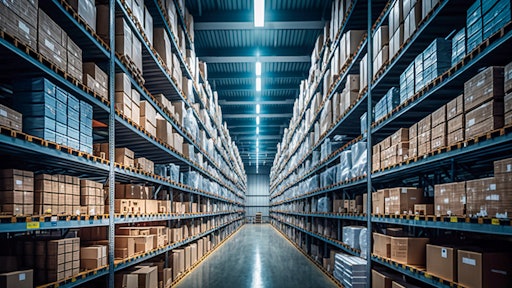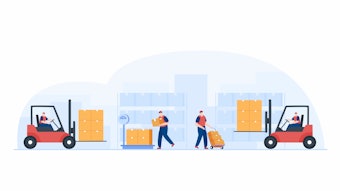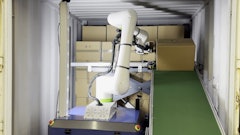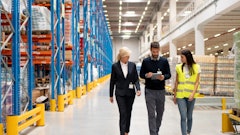
Everyone wants their warehouse to run like a well oiled machine. But unfortunately, that’s not always the case. Think about current issues your warehouse might be struggling with: trouble tracking inventory, low productivity, high volume of costly errors, unexpected downtimes.
While new forms of technology continue to be adopted to help with these problems, there’s still one fundamental option that offers multiple ways to create an efficiently run warehouse: labels.
When employed strategically, labels are invaluable tools that can easily boost warehouse management operations without breaking the bank.
So, if your warehouse is lacking in optimization and you're looking for help, here’s 3 ways labels can propel your management system skyward.
Using PandA!
Ever heard of PandA? No, it has nothing to do with the animal. PandA is an acronym used by warehouse personnel to mean ‘Print and Apply’ automation. Nifty, right?
Maybe you’re looking to elevate your manufacturing production line. Or perhaps you need to expedite your outbound process for better efficiency. For these types of warehouse management, using labels with print and apply technology is a great resource.
As labels are created and printed, a machine applicator applies them to products as they move along conveyor belts. Sometimes this action takes place at extremely high speeds. And for warehouses engaged in high-volume or high-speed production, ensuring quick and accurate label placement is essential for maximum throughput.
As a benefit, many print and apply automation tools can be programmed to seamlessly integrate into your internal supply chain operations. This way you’ll be able to accelerate efficiency and move products through and out of your warehouse at a much higher rate than any type of manual application.
Plus, they help eliminate human errors during the labeling process, ensuring every item is labeled correctly and consistently. And as your warehouse operations expand, print and apply automation systems can easily scale to meet increased demand as a future-proof solution.
What warehouse environment doesn’t want that?
Customization with LPNs
Ensuring precise tracking within your warehouse facility means having complete knowledge of items under your roof and their exact location at any given moment.
But how can this be achieved universally given the distinct characteristics of each warehouse? The answer lies with LPN (license plate number) labels.
LPNs serve as their own type of management system. Any barcode technology system your warehouse uses can easily access and track the information they carry, such as:
- Serial, lot, or part numbers
- Item quantity
- Location
- Inventory status
But one of the greatest attributes of LPNs is their ability to be customized to fit any unique warehouse’s requirements.
The series of sequential barcode numbers printed on LPNs provide each label with its own unique identification. Further customizations, like the addition of color or written text, can help enhance their identification.
Once these customizations have been made, the applications of these labels are endless. Pallets, bins, cases, shelves - you name it. And their adaptable to any type of placement enhances the structure of both inbound and outbound processes, including:
- Receiving
- Picking
- Storing
- Shipping
LPNs also have the ability to scale down large shipments for the purpose of more efficient inventory tracking.
Imagine a huge pallet order just arrived at your receiving dock. Rather than wasting time scanning dozens of individual barcode labels to find out the contents, one scan of a LPN label is all you need.
Employees can then easily and quickly break down and sort items with better accuracy and better optimization to get products where they need to be.
Advantages of Color Coded Labels
Even the simplest variation to a label design is beneficial in optimizing your warehouse space. In this case, a little color can help out in many different ways.
Color coded labels are a simple way to help warehouse personnel associate designated colors with certain warehouse areas, storage locations, or products. All of which can support warehouse management in the following ways:
- Increased productivity - Ever lost way too much time trying to find exactly where an item has been stored in your warehouse? When trying to locate products, colored labels are a strategic way to minimize confusion for workers. This makes tasks like picking a simple endeavor. The same can also be said for stowing away items when they arrive. Knowing an exact location boosts the mobility and productivity of personnel in any warehouse setting.
- Reducing human error - Yes, mistakes happen but that doesn’t make them any less bothersome. Using different colored labels to indicate specific items throughout warehouse space helps create fewer errors. This can be convenient for workers during busy times, like seasonal holidays, where errors are more likely to occur. Less errors on your end means happier customers in the long run. Everybody wins!
- Improved safety - Storing or moving dangerous chemicals throughout your warehouse? A bright colored label is a quick and effective way to signal hazardous materials are in play and that a little extra care is required. Drawing attention to important products your workers are handling increases both their safety and the safety standards of your warehouse. A fluorescent red or shocking yellow label can make all the difference in areas where caution and safety protocols are 100% necessary.
Optimizing Your Warehouse to the Fullest
As your warehouse operations evolve and expand with every new order, maintaining effective procedures is crucial for achieving optimal performance. And the secret to unlocking this type of optimization lies in labels.
Utilizing and customizing labels to address the unique challenges your warehouse faces can greatly improve the efficiency of your production processes. Results in enhanced speed and accuracy, improved productivity and traceability, and fewer errors are all critical to meeting expectations and keeping customers satisfied.
Who knew labels could be such a powerful device?

























